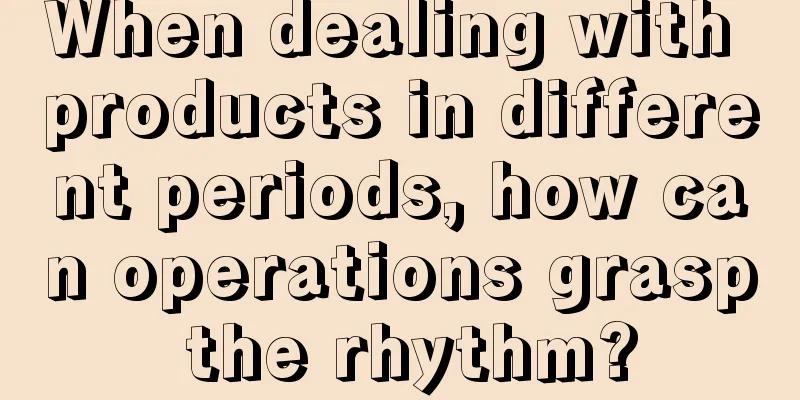How to increase product user growth? Share the 8-step plan!

|
The author uses a real case to explain how to build a complete eight-step user growth plan through layer-by-layer analysis when faced with a user growth dilemma. Let’s take a look at what the author has to say for specific details. A few days ago, a fan of a public account asked me a question. This question caught my attention and aroused my interest in answering it. The problem is as follows: Here, please think about it for 2 minutes. If you were asked this question, how would you answer it, or how would you think about it? Then continue reading. You might think like this:
After you list the possible reasons why there is “no consultation volume”, start to give specific solutions to specific problems. If you think in this dimension, then you are an ordinary operator and you are just providing specific solutions to specific problems. Or, you might think like this:
If it is suitable, then you will consider the specific problems and solve this step specifically. If your thinking is at this step, then congratulations, you are an excellent operator. Or, you might think:
If you start thinking from this point and then break down the specific problems to be solved step by step, then congratulations, you are a top operations expert.
So, what is the logic behind the thinking of top experts when they think systematically about the issue of user growth? This leads us to the topic we want to talk about today: The eight steps are:
Next, I will talk about them one by one. Step 1: Find the PMF Before any startup enters growth phase, it must find the match between product and market as quickly as possible. There are many methods and means to help you find the match between product and market. The method I often use here is the core guiding ideology mentioned in the book Lean Startup: “Hypothesis-Verification-Feedback-Adjustment”.
Suppose the customer you are trying to serve has a problem? And how would you solve their problems? Let us first understand what is a hypothesis? Western philosophy says: "I do not admit that what I see is reality. It is just an illusion or a phenomenon. Since what I see is a phenomenon, I can only assume what really exists." This is called fiction, or hypothesis. Only when you have an assumption will you ask questions, and only when you have an assumption will you need to prove and verify. For example: Your company is developing a smart scenic spot SAAS system. So how do you assume what problems the customers you serve have? Through learning, accumulating industry knowledge, analyzing competitors, and observing and analyzing the scenic spots with your own eyes, you have a basic assumption: it is very troublesome to issue tickets manually at the scenic spots offline, and an online transaction ticketing system is needed. Is this assumption complete? No, based on the basic assumptions, we can continue to ask questions until we get to the most essential assumptions. Further questioning, is the need for an online transaction system just to solve the problem of manual ticket issuance? It turns out not to be, but also because if the scenic spot does not have its own online ticketing system, a lot of profits will be lost to major OTA channels; When asked further, the scenic spot also hopes that tourists will pay attention to the scenic spot’s official account when paying through the scenic spot’s ticketing system, so that refined operations can be achieved for tourists; Further questioning... In the end, we may have come to the most essential assumption that the scenic spot wants a set of smart solutions to achieve the following: increase scenic spot revenue and reduce scenic spot costs. Then you start trying to come up with solutions. The smart scenic spot SAAS system solution provided to scenic spots includes several major modules: smart marketing, smart service, smart management, smart operation, and smart business.
Based on the given solution, start drawing the MVP (minimum viable product), which can be drawn on paper, a presentation template presented in PPT, or a flowchart and prototype drawn with Axure. Then start connecting with the market and users to see if users are willing to pay for such products. Let’s take the scenic spot mentioned above as an example. After drawing the MVP, you can start communicating with relevant personnel in the scenic spot with the plan to see the customer feedback. The scenic spot may feedback that such a plan is good; it may also feedback many things that you didn’t expect, such as: they don’t know how to use the system? They are only willing to pay for the final effect brought by the system, etc. At this time, possible options are to improve the MVP and then communicate with users; or to start promoting product development and then interact with the market after development. Which specific choice should you make? This is a good question, but I don’t have a good answer. You need to decide for yourself. If you feel it is almost done, then develop the product. If you feel it is not yet ready, then focus on perfecting the MVP first.
Whether you are communicating with customers about the drawn MVP, communicating with customers about the developed product, or communicating with customers about the entire "product + service" solution, every communication with customers will get feedback. Constantly adjust MVP, product, or "product + service" based on the feedback. Ultimately, is product-market fit (PMF) achieved? After multiple cycles of "hypothesis-verification-feedback-adjustment", there will be some indicators to measure. As mentioned above, the smart scenic spot SAAS system has several important key indicators for reference: retention rate, activity rate, payment rate, and repurchase rate. Only when customers stay and are willing to use the product for a long time and are willing to pay, does it represent that the market accepts the product. Once you find the match between the market and the product, you can move on to the second step of growth: “Set a growth goal.” Step 2: Create a Growth Goal How to set growth targets?
Neither of these is a good growth target. Why? These goals all have one direction: to find clear goals in clear strategies, and then to find clear action paths in clear goals. However, friends who have started a business know that: In reality, the goals we pursue are often vague, unclear, incoherent, and unstable, and are only clarified in the process of action or even in the results of action. In other words, is it certain to develop 3,000 distributors in a specific industry? Is this the ultimate goal? In order to achieve the ultimate goal, is it enough to develop 3,000 distributors? The answer is: not necessarily; this is not the ultimate goal; it may not be solved, and these will be adjusted in the process of promoting growth. So what is a good growth target? Noah Kagan, a member of Facebook's growth team, said: A good goal is one that is directly related to revenue. For example: The revenue target of a scenic spot A is 10 million? Let's break down this indicator: Assuming that the average tourist spends 500 yuan in the scenic area (this includes all the profitable items of the scenic area, such as tickets, accommodation, catering, other secondary sales products, etc.), then the number of tourists visiting the scenic area needs to reach 20,000 to achieve a revenue of 10 million. The ultimate growth goals are:
This is a good growth target. After the growth target is determined, start the third step. Step 3: Set a Time Frame Once the growth target is determined, growth will only be meaningful if it is achieved within the specified time. If the same turnover is 10 million, it is obviously different if the goal is achieved in one year or three years. At the same time, if there is no time frame constraint, no one from managers to executive employees will feel a sense of urgency, and you will not be able to track progress, and the final result will be greatly reduced. How to set the time frame? Give a deadline for achieving the goal based on business characteristics and resource capabilities. for example: A certain scenic spot A achieved a revenue growth of 10 million in one year; During the three off-seasons of spring, summer and autumn, the company achieved a revenue growth of 3 million (attracting 6,000 people), and during the peak season of winter, the company achieved a revenue growth of 7 million (attracting 14,000 people). Only by setting a time frame can it be authorized, traceable, inspectable and adjustable. After the specific time frame is set, the next step is step 4. Step 4: Make a list of potential channels In order to achieve your growth goals within a certain time frame, you need to list a series of customer acquisition channels. Channel 1/2/3: Then draw out the traffic - click-through rate - conversion rate - number of users - status - whether executed? - actual users for each channel in the channel list. For example: Let’s take scenic spot A as an example
OTA platform, offline travel agencies, cross-industry cooperation, distribution channels, self-media channels, docking with corporate team building, enterprises and institutions, large classroom channels for primary and secondary school students, etc.
That is, make an estimated statistics on the traffic volume of the channels you listed.
How many users will enter the product details page or marketing promotion page of the product you are promoting?
Among the users who visit the page, what percentage are paying users? In other words, what is the approximate proportion of tourists attracted to spend money in the scenic spot.
This channel has brought a lot of users to the park for consumption.
Whether the scenic spot has established connections with the channels it wants to promote.
Has the scenic spot started formal promotion through this channel?
After the official promotion, this channel brought a large number of users to the scenic spot. Once you have a list of potential channels, you can move on to step five. Step 5: Evaluate channel feasibility How to evaluate the feasibility of a channel? Think about where users are most likely to come from? ——List N basic ways to acquire customers——Select the channel that best matches the customer acquisition method. For example: Take scenic spot A as an example A scenic spot plans to hold several offline activities in the spring, and wants to acquire customers through online fission. At this time, we think about where the users may come from? After sorting out, you find that users may see event information from their Moments, communities, and public accounts. At this time, your preferred channels may be your own self-built media and third-party self-media. You may also be able to push distributor channels to promote the event. You may even be able to sell tickets for this event through OTA channels. Step 6: Predict the results There is no need to elaborate on this step. You can break down the growth indicator of turnover and determine how many users each channel needs to acquire to achieve the goal. Then you need to predict the results in advance to see whether each channel can achieve the target. Step 7: Create a promotion timeline Break down the overall user growth goal into short-term goals and put them into a time plan. Then, in a series of timetables, we will advance the promotion tasks, regularly achieve short-term goals, and ultimately achieve the overall user growth goal. For example, taking scenic spot A as an example, in the task timeline formulated by scenic spot A:
Then, the short-term goals achieved through channel promotion in each period of time are accumulated together to form the overall user growth goal. Step 8: Track channel performance The effectiveness of the channel needs to be tracked and data analysis conducted. Then the decision may be made to abandon the channel; or the traffic funnel may be optimized within the channel. For the key links such as traffic, click-through rate, conversion rate, and transaction volume, if any link has obvious problems, that link will be iteratively optimized. Conclusion After giving an overall talk on "How companies can increase user growth and build a complete user growth plan in eight steps", let's use this idea to think about the problem mentioned at the beginning of the article.
Then start scheduling and developing an implementation plan; collect data and track channel data, and ultimately decide whether to abandon the channel or perform iterative optimization of the channel operation methodology. After I shared some of the thoughts in this article with the fans on the official account who asked me this question, her answer was similar to what I thought. She replied: "The team is also considering it. After trying for a period of time, we may find that B-side products are indeed not suitable for e-commerce platforms, so we will change our overall strategy." Finally, I hope this article will be of reference value to you, that’s all. Author: Feng Xianfei Source: Xiao Feige's Notes (f1506620495) |
<<: Short video promotion skills in the home improvement industry, with successful cases!
>>: Essential for overseas promotion: What are the global advertising channels?
Recommend
Product operation: Let users share the deep logic of fission!
A good product will make users want to share, spo...
A complete collection of the latest hot topics in April 2018, a must-have for operations and promotions!
Dear new media and marketers , April is about to ...
Product promotion is not effective, how to solve it?
Many friends asked, what should I do if I have tr...
25 tips for career counterattack: From a monthly salary of 3,000 to an annual salary of 1 million
Whether you are a newcomer to the workplace or a ...
18 APP promotion experiences, each one is worth money! !
Today I’d like to share some tips on APP promotio...
Which cities have the most universities? Ranking of cities with the most universities in 2020
In recent years, China's education has develo...
Baidu bidding promotion, how to optimize keyword quality?
In order to optimize the quality of keywords, you...
What is the core of the brand breakthrough strategy of the To B industry?
The influence of brands has been weak for a long ...
The Lantern Festival is coming, how to write copy that takes advantage of the situation?
It’s the Lantern Festival again. Have you thought...
How to promote user growth by optimizing data!
With the development of the Internet, traffic has...
The underlying logic of Douyin e-commerce product selection
Anyone who has worked in e-commerce may have hear...
The SEO secret of earning 1 million per month from a single website
Brief introduction to the SEO secret resources th...
User Growth: Why isn’t your user base growing?
The changes of the times and channels will bring ...
2019 Pinduoduo Product Operation Analysis Report
Pinduoduo has rapidly grown into the third larges...
Uncle Wolf's Little Red Book Hot Product Promotion and Traffic Training Course No. 11
The 11th course catalogue of Wolf Uncle's Xia...









